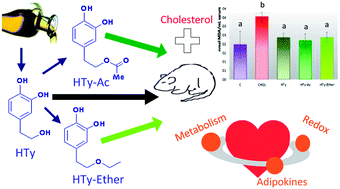Comparative evaluation of the metabolic effects of hydroxytyrosol and its lipophilic derivatives (hydroxytyrosyl acetate and ethyl hydroxytyrosyl ether) in hypercholesterolemic rats
Abstract
Hydroxytyrosol (HT), a virgin olive oil phenolic phytochemical with proven health benefits, has been used to generate new lipophilic antioxidants to preserve fats and oils against autoxidation. The aim of this work is to comparatively evaluate the physiological effects of HT and its lipophilic derivatives, hydroxytyrosyl acetate (HT-Ac) and ethyl hydroxytyrosyl ether (HT-Et), in high-cholesterol fed animals. Male Wistar rats (n = 8) were fed a standard diet (C group), a cholesterol-rich diet (Chol group) or a cholesterol-rich diet supplemented with phenolic compounds (HT group, HT-Ac group and HT-Et group) for 8 weeks. Body and tissue weights, the lipid profile, redox status, and biochemical, hormonal, and inflammatory biomarkers were evaluated. Plasma levels of total cholesterol, LDL cholesterol, glucose, insulin and leptin, as well as malondialdehyde in serum increased in Chol compared to C (p < 0.05). Rats fed the test diets had improved glucose, insulin, leptin and MDA levels and antioxidant capacity status, with HT-Ac being the most effective compound. The studied phenolic compounds also modulated TNF-α and IL-1β plasma levels compared to Chol. HT-Ac and HT-Et improved adipose tissue distribution and adipokine production, decreasing MCP-1 and IL-1β levels. Our results confirm the metabolic effects of HT, which are maintained and even improved by hydrophobic derivatives, particularly HT-Ac.


 Please wait while we load your content...
Please wait while we load your content...